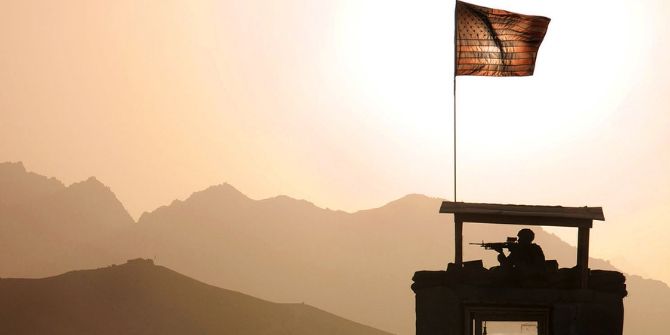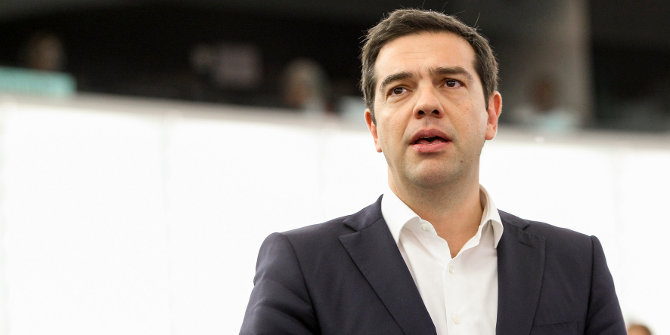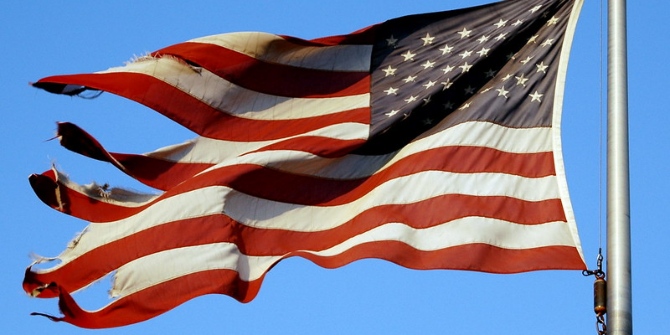 A newly published special issue of LSE Public Policy Review aims to provide an in-depth analysis of the deeper reasons for the ongoing conflict in Afghanistan, covering the whole period from the Soviet invasion of December 1979 through to the final western withdrawal in August 2021. Here Michael Cox introduces the discussions of how the Taliban finally triumphed and what this means for Afghan society. He discusses how competing actors in the international system have reacted to the Taliban takeover; whether the West’s withdrawal represented a major or only a temporary setback for NATO and the United States; and why for the foreseeable future there is not likely to be any improvement in the situation in Afghanistan.
A newly published special issue of LSE Public Policy Review aims to provide an in-depth analysis of the deeper reasons for the ongoing conflict in Afghanistan, covering the whole period from the Soviet invasion of December 1979 through to the final western withdrawal in August 2021. Here Michael Cox introduces the discussions of how the Taliban finally triumphed and what this means for Afghan society. He discusses how competing actors in the international system have reacted to the Taliban takeover; whether the West’s withdrawal represented a major or only a temporary setback for NATO and the United States; and why for the foreseeable future there is not likely to be any improvement in the situation in Afghanistan.
It is one of the many tragedies of our time that in an era of ‘great power peace’ bloody conflicts have broken out on the so-called periphery of the international system with immense regularity. The list almost seems endless from Central and Southern Africa, where countries like Rwanda and the Democratic Republic of the Congo have experienced the most brutal conflicts right through to the Middle East, where one country after another—Syria, Lebanon, and Yemen being perhaps the most recent—has undergone that most appalling of experiences: civil war made worse by the intervention of outside actors and powers. And so it was also with Afghanistan.
Four decades of conflict in Afghanistan
Whether we believe Afghanistan has suffered more or less than these other countries is not a question that can ever be answered. All one can say with certainty is that like them—but for much longer—it has experienced the most violent of conflicts going right back to late 1979 when the Soviet leadership, then led by KGB man Yuri Andropov, took what its military believed was an ill-considered decision to intervene. As the UK’s former Ambassador to the USSR and Russia, Rodric Braithwaite shows in the first contribution to the LSE Public Policy Review issue, not only did this have major consequences for the USSR (some even claim it accelerated the system’s demise), it had even more devastating results for Afghanistan itself.
The trauma did not come to an end when Moscow finally decided to leave 10 years later. A long civil war then ensued, followed in turn by Taliban rule supported by Al-Qaeda (AQ), who then went on to attack the United States on 9/11. This in turn precipitated a large-scale intervention by the West, the main burden of which was borne by the USA. Born of high hopes that Afghanistan could be turned into a functioning democracy with a thriving market economy, within 10 years the mission was already creaking, by 2014 most Western troops had left, and by August 2021 the United States finally decided to call time on what President Biden—never an enthusiast—termed the ‘forever’ war.
Western analysts never cease reminding us how much Afghanistan cost the West and the US in terms of ‘blood and treasure’. Indeed, Biden himself laid great stress on how much the war had cost the United States in his various speeches and statements defending his decision to leave. But for Afghanistan and Afghans, the cost has been of a quite different magnitude. Obtaining accurate and reliable figures is by no means easy. Yet even the most conservative estimates point to a human disaster measured in numbers killed and injured, refugees created, and lives upended by an almost permanent state of war. Indeed, the Soviet intervention alone led to hundreds of thousands of civilian deaths, two million internally displaced people, and somewhere close to five million refugees.
During the decade of civil war that followed, there was further upheaval. The population of Kabul fell from around two million to 500,000, many more were killed or injured, and hundreds of villages were destroyed. After 2001, the number of casualties went down somewhat. Even so, possibly more than 200,000 people were killed over two decades, 70,000 of them civilians. Indeed, between 2016 and 2020 there were nearly 4,000 civilian casualties, including 1,600 children. This long list certainly tells us something. On the other hand, it tells us ‘very little about the conflict’s indirect costs measured in terms poverty, starvation, mental illness and life-long impacts on health and well-being’. Neither does it reveal much about the impact all this had on ethnic tensions inside Afghanistan itself. In fact, given that the Taliban were not exactly known for their commitment to Western-style democracy, some of its leaders (almost exclusively recruited from the majority Pashtun ethnic group) later blamed ethnic tensions for the failure of democracy to take root in the country.
The US war in Afghanistan
The narrative in the LSE Public Policy Review issue begins in effect with the 9/11 attack, followed by America’s initial military response, which then widened out to include NATO in what Sten Rynning of the University of Southern Denmark and Paal Sigurd Hilde of the Norwegian Defence University College show to have been its most significant mission out of area since the end of the Cold War. But first and foremost, this was a US war. Having determined the attack on the American homeland had been carried out by Bin Laden backed by the Taliban—a fact the Taliban to this day denies—the next move was to destroy the Taliban and its various allies.
Initially, at least, this proved to be relatively easy. However, what complicated the mission was, firstly, the imprecise legal basis upon which the war was justified, as shown by Devika Hovell and Michelle Hughes of LSE’s Law School in their piece; secondly, Bush’s much-criticized decision to widen the ‘war on terror’ and invade Iraq; and finally, a lack of clarity about what the war was supposed to be achieving. Was it, as some assumed, merely to drive Al-Qaeda and its allies out of Afghanistan and then go home? Or was it a more ambitious goal of tackling the enormous task of reforming Afghanistan in the hope a new kind of polity and society, now purged of what President Bush called the evil of extremism, would finally emerge? As we now know, this turned out to be a bridge too far. Indeed, the broad consensus now seems to be that building a ‘new nation’ in a country as rural, conservative, and indeed as poor as Afghanistan was ‘always destined to fail’. Yet, to many of those on the ground at the time, it seemed as if this was the only thing that could possibly justify the ongoing war against the Taliban.
At the start of the Western operation, the sheer unpopularity of the Taliban was perhaps the biggest advantage held by the US-led coalition. The problem was that as the occupation went on, not enough Afghans saw immediate benefit for themselves, giving the Taliban time to regroup, then gain ground, and finally, as Florian Weigand of LSE’s International Development Department shows in his contribution, to win yet again in 2022. That said, something was achieved, especially through the vehicle of several international agencies often working under the auspices of the UN. There were certainly some ‘bright spots’, including a lowering of ‘child mortality rates, increases in per capita GDP, and increased literacy rates’. Even so, a great deal was not done, and many opportunities were missed by the West.
Yet because of the sheer determination shown by many Afghans, women in particular—an issue discussed by Nargis Nehan, founder of EQUALITY for Peace and Democracy – some improvements did take place. But as Afzal Ashraf and Caroline Kennedy-Pipe of Loughborough University also demonstrate, much more might have been achieved on women’s situation if it had not been for the West’s basic misunderstanding of the cultural and tribal customs of much of Afghan society itself. Nonetheless, whereas in 2003 fewer than 10 percent of girls were enrolled in primary schools, by 2017 that number had grown to 33 percent. Meanwhile, female enrolment in secondary education grew from 6 percent in 2003 to 39 percent in 2017. Women’s life expectancy also grew from 56 years in 2001 to 66 in 2017, and their mortality during childbirth declined from 1,100 per 100,000 live births in 2000 to 396 per 100,000 in 2015.
Why did the withdrawal from Afghanistan fail so badly?
Success, they say, has many parents, but failure is often an orphan. It is thus inevitable that this PPR issue, written in the shadow of the West’s hasty and ill-planned withdrawal in August 2021, reads a little bit like a catalogue of failure. Perhaps if it had been composed a few years earlier when the Taliban only controlled a small part of the country and the future looked less bleak, the authors here might have been able to put more of an optimistic gloss on what happened. But given the speed with which the whole coalition effort imploded, leaving so many Afghans behind, it is hardly surprising that the analysis now tends to assume the question that really needs answering is not what went right but, rather, why did the whole effort fail so badly?
Even the withdrawal was handled badly, and what should have been a carefully planned evacuation turned into a messy and bloody rout. As Leslie Vinjamuri of SOAS University of London and Chatham House, Biden had never been keen on the mission and made it clear in his run for the White House in 2020 that America would be withdrawing sooner rather than later. To that degree he made good on his election promise. However, the chaotic character of the departure, with masses of desperate Afghans trying to get on a plane at Kabul airport, did little to enhance America’s reputation as an ally one could trust. Quite the opposite in fact. If anything, the way in which the US got out ‘shredded’ not only its reputation and that of President Biden but also that of the ‘entire western alliance’ as well.

“Security at sunset” (CC BY 2.0) by The U.S. Army
Meanwhile, in Afghanistan itself, the hasty retreat into exile of the Ghani government and its replacement by the Taliban has only led to what looks like the almost complete collapse of everyday life. No doubt some hoped that the new Taliban would not be like the old one. But such hopes were quickly dispelled. The rhetoric of the Taliban may have moderated somewhat since 2001, but their extremist beliefs do not appear to have changed at all. As one seasoned observer has noted, ‘All evidence suggests the Taliban still believe in restoring their old system of an emirate, in which an unelected religious leader, or emir, was the ultimate decision-maker’ given authority from God. Since seizing control, the Taliban leadership have shown little inclination either to share power or to concede anything to the demands of the international community to respect human rights.
The insurgent group expected a complete handover of power, and this is precisely what happened. Thus, the first new interim government contained no women, the interior minister was a long-standing member of the Haqqani network, who also happened to be on an FBI wanted list, and one member of the government was a former Guantanamo detainee who had, it was rumoured, been close to Bin Laden (something he denied). No doubt under pressure from more friendly countries like Pakistan, Russia, and China to do something, the Taliban leadership did go on to make additional appointments on September 22. This very slightly broadened the new government’s makeup, but it did not fundamentally alter its Pashtun character, neither significantly were any women added. As one observer pointed out, it was clear the Taliban were not willing to ‘make any significant concessions for the sake of international recognition, sanctions relief or the resumption of aid from Western governments’.
The worsening situation in Afghanistan
Since then, it is difficult to detect any sign of positive change, either in the government’s outlook or in terms of what is happening on the ground itself. On the contrary, the situation appears to have moved from the desperate, immediately following the almost Vietnam-like withdrawal of US forces in August 2021, through to the deeply tragic. Neither does the situation look like it will improve in the near or medium term. As Michael Callen of the LSE’s Economics Department, and Shahim Kabuli of the former Government of the Islamic Republic of Afghanistan explain, the Afghan economy was hardly in great shape before the Taliban takeover, but since then, the situation has become a good deal worse. The war may have come to an end, but the economic situation remains distinctly bleak.
Indeed, only a month after the West’s withdrawal, the International Monetary Fund (IMF) was estimating that the Afghan economy would contract by 30 percent by the end of 2021, with appalling human consequences. And so it turned out. In fact, only a few months later, the UN was already calculating that Afghanistan would see a rise in people in need of humanitarian assistance ‘from 9.4 million in 2020 to 24.4 million in 2022’. It also identified the many reasons for this, ‘including the suspension of much foreign aid, which had financed around 75 percent of public spending in 2019, the Taliban’s decisions to ban the use of foreign currency and many women from employment, shortages of cash due to the demobilisation of security forces, non-payment of civil servants, and restrictions on access to Afghan assets held abroad’.
All this in turn has only exacerbated an already desperate situation, not only for those who had to remain—the United Nations Development Programme (UNDP) talked openly at the end of 2021 of the need to avert a ‘basic needs crisis’—but also for those who had been forced to flee the country. Towards the end of 2020, the UN High Commissioner for Refugees, Filippo Grandi, was already warning of Afghanistan’s refugee crisis being at a breaking point. Equally challenging was life for those who had been displaced within Afghanistan itself. As another UNHCR official pointed out just after the Taliban had seized control, the refugee flow would no doubt continue. But the ‘displacement crisis’ was equally critical inside Afghanistan, with over 3.5 million Afghans having been uprooted by conflict.
What’s next for Afghanistan?
Assuming that there is no easy solution to the current crisis, we are nonetheless compelled to think creatively of policies that might at least help alleviate the situation. Those who are less hostile to the Taliban, like Iran or Pakistan, could help, as of course could China, whose attitude towards Afghanistan is discussed in detail in this collection. Yet as Feng Zhang of the South China University of Technology shows, even the Chinese will be cautious when it comes to getting involved. Iran, meanwhile, may welcome the departure of the Americans. Whether or not it is likely to provide serious backing for a regime of a different theological cast of mind to its own is not so clear. Moreover, having already played host to millions of Afghan refugees, it is unlikely to be willing to welcome many more. Russia, of course, is well positioned to gain new leverage in Afghanistan. Moscow, in fact, could hardly contain its joy at what finally happened to the US. Yet given its now almost complete preoccupation with the war in Ukraine and the impact that sanctions are having on its own economy, it is unlikely to spend too much time worrying about Afghanistan.
In a strange twist of fate, therefore, all roads once again lead back to the West. Thus far no Western government has recognized the Taliban and, for the time being, are most unlikely to unfreeze Afghan assets or advance the new government in Kabul the aid it so desperately needs. Talks continue between the parties, but as the discussions in Oslo in January 2022 showed, Western donors will not make any significant material concessions to the Taliban unless the Taliban is willing to undertake policies like widening the government, protecting human rights, and providing girls and women much greater access to education.
Many in the West meanwhile continue to press for sanctions to be lifted, if only to prevent a looming humanitarian crisis. To leave hundreds of thousands of people starving is, as one policy-maker put it, not an option. But there is still a long way to go. The bitter legacy of the war, the brutality displayed by the Taliban throughout the conflict, and the way in which it took over and has since run the country does not at this moment leave much room for hope.
Then, as if the situation was not dire enough, came the Russian invasion of Ukraine February 2022. Indeed, with the West’s attention now concentrated almost completely on the humanitarian crisis facing Ukraine, what little hope there may have been for Afghanistan has been dealt a serious blow. Once again, Russia appears to have become the arbiter of Afghanistan’s destiny. Whether or not its war against Ukraine becomes ‘Putin’s Afghanistan’ remains to be seen. But for Afghanistan itself, the consequences of what is going on in Ukraine look to be little short of disastrous. As Afghanistan’s former ambassador to Ukraine, Sardar Mohammad Rahman Ughelli, has reminded us all—more in sadness than in anger one suspects—the world is already forgetting about Afghanistan, leaving the Taliban free to implement their policies with little or no international scrutiny. The Afghanistan tragedy, one fears, still has a long way to run.
- This is an edited and shortened version of Michael Cox’s introduction to the LSE Public Policy Review issue, available open access here. For the footnotes to back up statistics and analysis above, please see his original article.
Please read our comments policy before commenting.
Note: This article gives the views of the author, and not the position of USAPP – American Politics and Policy, nor the London School of Economics.
Shortened URL for this post: https://bit.ly/3Pu5Rf0
About the author
 Michael Cox – LSE IDEAS
Michael Cox – LSE IDEAS
Professor Michael Cox is Emeritus Professor of International Relations at the London School of Economics, and Director of LSE IDEAS (LSE’s foreign Policy think tank).






